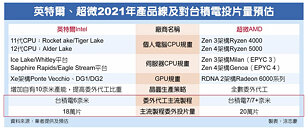Monday, July 27th 2020

TSMC Allocation the Next Battleground for Intel, AMD, and Possibly NVIDIA
With its own 7 nm-class silicon fabrication node nowhere in sight for its processors, at least not until 2022-23, Intel is seeking out third-party semiconductor foundries to support its ambitious discrete GPU and scalar compute processor lineup under the Xe brand. A Taiwanese newspaper article interpreted by Chiakokhua provides a fascinating insight to the the new precious resource in the high-technology industry - allocation.
TSMC is one of these foundries, and will give Intel access to a refined 7 nm-class node, either the N7P or N7+, for some of its Xe scalar compute processors. The company could also seek out nodelets such as the N6. Trouble is, Intel will be locking horns with the likes of AMD for precious foundry allocation. NVIDIA too has secured a certain allocation of TSMC 7 nm for some of its upcoming "Ampere" GPUs. Sources tell China Times that TSMC will commence mass-production of Intel silicon as early as 2021, on either N7P, N7+, or N6. Business from Intel is timely for TSMC as it is losing orders from HiSilicon (Huawei) in wake of the prevailing geopolitical climate.
Sources:
Hexus.net, Chiakokhua (Twitter)
TSMC is one of these foundries, and will give Intel access to a refined 7 nm-class node, either the N7P or N7+, for some of its Xe scalar compute processors. The company could also seek out nodelets such as the N6. Trouble is, Intel will be locking horns with the likes of AMD for precious foundry allocation. NVIDIA too has secured a certain allocation of TSMC 7 nm for some of its upcoming "Ampere" GPUs. Sources tell China Times that TSMC will commence mass-production of Intel silicon as early as 2021, on either N7P, N7+, or N6. Business from Intel is timely for TSMC as it is losing orders from HiSilicon (Huawei) in wake of the prevailing geopolitical climate.

27 Comments on TSMC Allocation the Next Battleground for Intel, AMD, and Possibly NVIDIA
Intel have cash, lots of it. Maybe they figured its time to start burning it. Better late than never...
with contracts signed to supply existing customers
its going to come down to Intels FAT Wallet i suspect that wafer costs will rise due to demand and that finite supply !!!
Bulk wafer auctions anyone
Because that is what Intel does best.
And just to be clear, this IS war, no if's, andz, or BUTTs about it, and TSMC doesn't/won't give a crap whoelse wins or loses, as long as the mega-huge-giga-normous orders keep coming in from all sides, they are in it to win it, in no uncertain terms :rockout:
Cutthroat you say...nah, surely not :fear:
Intel did this to themselves and has nobody else to blame...
I'm soooo glad I bought a bunch of TSMC shares back when they were a much smaller & undervalued company (just like I did with that little fruit stand in Cupertino !) ..:respect:..:p..:peace:
TSM has shown that they're willing to re-invest billions into their company to grow and be more competitive, and that trust in their own business has paid off. Lesser management would have pissed the money away with stock buy-backs or overly large dividends for short-term stock price returns, but they've grown the value of their shares by growing the value of the company.
Don't know if it's true or not, but certainly story looks different. Link:
www.extremetech.com/computing/313222-intel-amd-reportedly-fighting-for-capacity-at-tsmc
It's a clickbait.
I never said I do and never said that I think the other article is true, and this one is false. Just pointed that at the same time *this* rumour came up *different* rumour came up, too.
Peace...
2) No way Xe was developed on TSMC processes and no way it could be trivial to just jump off Intel's fab
3) It will largely depend on size. Millions of A100 chips is one thing, millions of 250mm2 chips is another. Note that for consoles alone, AMD will be ordering tens of millions of 300mm2+ chips.
So for one, we need to keep in mind Intel 10nm = TSMC 7nm and Intel 7nm = TSMC 5nm. Intel really only needs more 5nm which is almost entirely taken up by Apple this year, and they only need it in very specific scenarios. Given the relatively low volume required for PVC (keep in mind that Intel makes upwards of half a billion CPUs per year) the order is quite small.
Also note that 7nm at Intel is not ready for *volume* production (the 500M CPUs per year kind of volume), but they don't need to get high yields for this.
With that, from the article below :
"So we independently reached out to a couple of sources in Taiwan and got the facts first hand ...
- TSMC's 5nm process is roughly comparable in density to Intel's 7nm process and PVC is only feasible at that density level - so 6nm (which is an optimized process for TSMC 7nm) is out of the question.
- Ponte Vecchio will have multiple SKUs.
- All PVC SKUs will have an IO die made at Intel.
- Compute dies will be made either on Intel's 7nm process or TSMC's 5nm process depending on the exact SKU.
- The Rambo cache will be made in-house at Intel as well.
- The connectivity die (Intel Xe) was originally intended to be built over at TSMC and will remain that way.
- Intel did place an order worth 180,000 wafers on the TSMC 6nm process but it is not related to PVC and is part of their ongoing partnership (Intel has been using TSMC for quite a long time)."
wccftech.com/exclusive-intel-ponte-vecchio-gpu-not-on-tsmc-6nm/